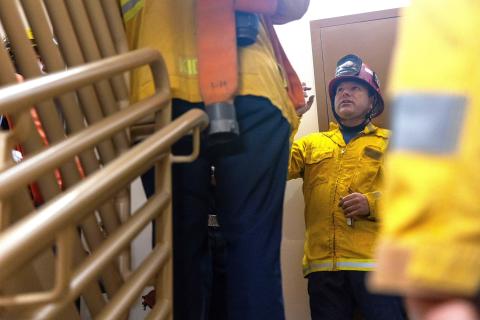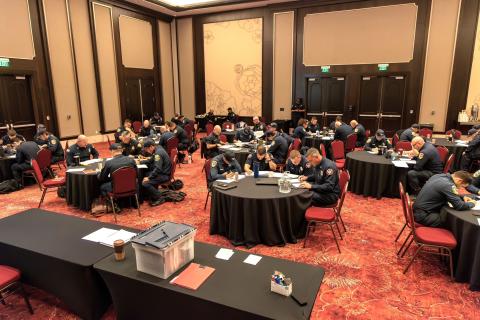As part of their ongoing effort to ensure safety in the event of emergencies, the Soboba Band of Luiseño Indians hosted the California State Fire Marshal’s course for Incident Management of High-Rise Fires at its Soboba Casino Resort, Nov. 4-8. The classes, skills instruction and drills allowed more than 50 firefighters the opportunity to learn all the ins and outs of how to respond to high-rise fires. CAL FIRE/Riverside County Fire Department has three of the very few State instructors certified to teach this course.
CAL FIRE’s Scott Lewis, Fire Captain with the Training Bureau, oversees the high-rise fire operating cadre that serve as instructors for the annual event that has been held at Morongo and Pechanga in previous years. He has worked for CAL FIRE for the past 26 years and has spent 23 years in the area of training, joining the Training Bureau two years ago.
While the Soboba Casino Resort hotel is classified as a mid-rise building at six stories, whereas high-rise buildings are typically 10 stories or higher, it offers a typical layout with a lobby, elevators, stairwells, water supply systems, and more.
The weeklong training consisted of a combination of lectures, hands on-training, and ended with two days of full-scale scenarios. The logistics drills put all the lessons into action. There was participation from several fire departments, aside from Soboba. Crews from Morongo, Pechanga, Palm Springs, Cathedral City, Loma Linda, CAL FIRE Riverside, CAL FIRE Santa Clara Unit and CAL FIRE Tuolumne-Calaveras Unit took part in the training. Members of the Orange County Fire Authority were there in a “train the trainer” role so they could take the learned information back to their stations.
Soboba Fire Captain Gabe Herrera said the purpose of Wednesday’s training was to reinforce the knowledge the crews had learned in the lectures Monday and Tuesday. A written test of 50 multiple choice questions was administered that morning, with all students passing. Herrera said it’s important for all personnel to learn how to fight these types of fires because they are so different from other types.
High-rise incidents are referred to as “low frequency, high risk” and take over 100 firefighters to handle, with the goal of achieving knock down with 30-40 firefighters within 30-40 mins with one hose line. Additionally, Lewis said, “Casinos are very unique; they are not standardized, and every building has its own nuances and ins and outs.” He said it was very helpful for Soboba staff to provide them with the opportunity to have a walk through to prepare for this event, which took about six months to plan and coordinate.
Part of the preparation included assistance from the Moreno Valley College School of Public Education who sponsored the class so all students will receive college credits for their participation. The school assisted with the registration process for all who enrolled.
Fire Captain Scott Mason is a third-generation firefighter who has been with CAL FIRE for 28 years. California has a cooperative agreement, sort of like a super mutual aid, and CAL FIRE controls the movement up and down the state. They are divided into zones/regional groups that can deploy assets north and south, as needed.
Because newer high-rise buildings are modernized and have state-of-the-art detection systems, it was helpful to have Soboba Fire Captain John Hines involved since he spent 22 years with the Long Beach Fire Department where there are many older high-rise buildings that are more susceptible to fires.
Hines helped write some of the standards used in this type of training. After leaving Long Beach, he was happy to have the opportunity to join Soboba Fire. “It’s a different program out here,” he said. “I’ve met a lot of nice people, and I get to train others.” Hines is also a member of the Riverside County Training Officers’ High-Rise Cadre.
The importance of having so many different agencies learn how to handle these incidents cannot be minimized. If a working fire should break out at SCR, there are not enough personnel within their own fire department which employs about 20. Hines said more than 100 would be needed.
“This type of training brings us all together to get on the same page to be prepared when all hands have to be on deck,” Hines said. “It’s tremendous that Soboba is hosting this.”
Lewis, who trains throughout Riverside County, said even with 94 stations within the CAL FIRE Riverside County Fire Department, they could not handle a major incident on their own. “We all train together to learn the same tactics and strategies, so we are all on the same page of music; it’s a team effort,” he said.
He said at least one ladder truck on scene is crucial since they are basically rolling toolboxes with lots of equipment, such as generators, that may be needed. Large fans are always needed to pressurize a stairwell that has heat and flames on the other side of the door that leads into the hallway of the hotel.
“The staff here has been very accommodating, professional and cordial,” Lewis said. “They have bent over backwards to be great hosts and will be involved in a drill, interacting with our crews so they can actually run an incident.”
Battalion Chief Chad Durrance has been with Pechanga Fire Department for 22 years. He provided support for the walkthroughs that the students took on Wednesday so they could familiarize themselves with the layout and where things were located. When performing simulations on Thursday and Friday, they learned where to find the systems and water supply or how to get the hoses up to the fifth-floor stairwell, if that is the area they were assigned to for the drill.
“Every step of the way, we do evaluations and answer any questions; it helps reinforce everything they learn and helps them be more successful,” Durrance said.
Lewis said learning fire behavior is key to any firefighting effort and that interiors with certain finishes and plastic elements can potentially release flammable vapors and harmful gases and chemicals put into the air (off-gassing). He also explained that furnishings and walls absorb heat. “Picture a sponge so saturated with water that one more drop will cause it to release one drop,” he said. “The same thing happens when heat is absorbed; once full, it will radiate heat back into the room (thermal radiation feedback).”
It is not as simple as aiming a water hose at flames when it comes to gaining control of a fire. There is a lot of math involved. The water pressure in the hose must be adjusted to ensure there will be at least 50 PSI at the nozzle, for instance.
Angel Hendrie has been a firefighter for 29 years, 18 of which have been working for CAL FIRE. She loves her job because “every day is different.” She said, “I have literally climbed trees to rescue cats – you don’t know what you are going to get each day or who you’re going to meet.”
She said the high-rise incident training has been very helpful and has helped her feel more prepared should she be called to assist with such a fire. “It gives me a broader picture,” Hendrie, of San Diego, said. “It’s so easy to do (drills) in the fire station but being here and utilizing a real structure? In that sense, it’s very realistic. I have learned so much. I’m so thankful that the (Soboba) Tribe is allowing us to do this.”
Photos courtesy of the Soboba Band of Luiseño Indians, unless otherwise noted










